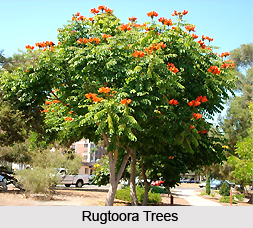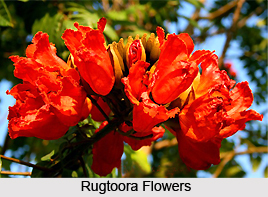Rugtoora is a useful Indian medicinal plant that is botanically known as Spathodea campanulata Beauv. The name of this medicinal plant varies from region to region. Rugtoora is the Hindi name of the plant and in  Kannada it is called as Lujjekaye, Neerukaye or Ucche Kaayi. The plant is named as Patadi and Patade or Patadiya in Tamil and Telugu, respectively.
Kannada it is called as Lujjekaye, Neerukaye or Ucche Kaayi. The plant is named as Patadi and Patade or Patadiya in Tamil and Telugu, respectively.
Rugtoora is quite a tall tree with a height of up to 22 m and has wide branches at the top. The plant is evergreen except in very dry areas, where it loses its leaves for a few weeks. The bark of the plant is smooth and has a light brownish-grey colour, while the leaves are imparipinnate. The length of the leaves is 30-45 cms and they have around 13-19 leaflets. The leaflets have an elliptical oblong to obovate shape. The base is rounded, margins entire and apex acuminate. The flowers of the plant are quite large (to 9 cms long and 6 cms broad) and the bell-shaped flowers have a colour of scarlet-red or orange. The flowers are borne in dense, pendulous, terminal racemes.
 The fruits or capsules of Rugtoora are of brownish-black colour and oblong-lanceolate. They have a length of 15-23 cms and width of 3-5 cms and they contain numerous seeds. The seeds are 1.7-2.4 cm broad including hyaline wing and they are winged all around. Though the plant is a native to tropical West Africa, it is commonly planted in the Indian gardens and along roads for its year-round display of flowers. The plant is sometimes planted along riverbanks for erosion control, as well.
The fruits or capsules of Rugtoora are of brownish-black colour and oblong-lanceolate. They have a length of 15-23 cms and width of 3-5 cms and they contain numerous seeds. The seeds are 1.7-2.4 cm broad including hyaline wing and they are winged all around. Though the plant is a native to tropical West Africa, it is commonly planted in the Indian gardens and along roads for its year-round display of flowers. The plant is sometimes planted along riverbanks for erosion control, as well.
Apart from having decorative and attractive features, Rugtoora has some useful medicinal properties and usages, as well. The dried, pulverized bark or fresh inner bark of the plant is used as a dressing for ulcers and other skin troubles. The Indian people use a decoction of the leaves and bark of Rugtoora as a soothing lotion. Another decoction of the bark is usually given for treating the diseases like dysentery, gastrointestinal and kidney troubles. Apart from that, the Indian people use an infusion of the leaves in the treatment of urethral inflammation, as well.



















